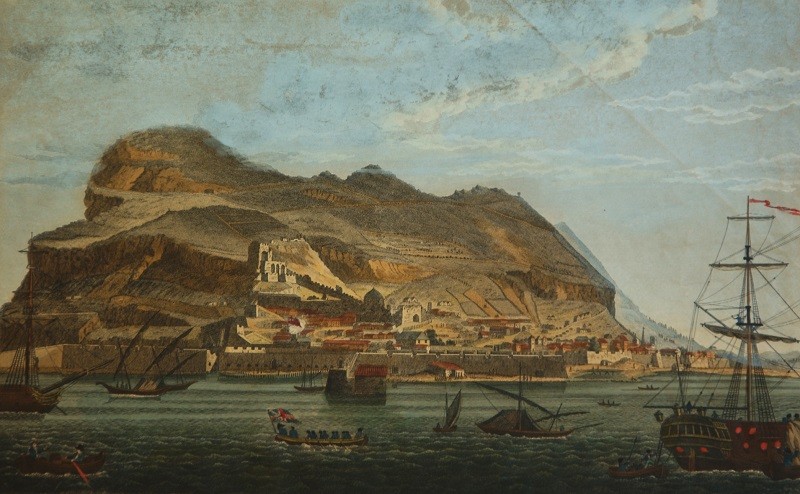Richard Ford’s visit to Gibraltar, 1845

Richard Ford’s visit to Gibraltar, 1845
Ford continues with a general description of the Rock:
“The bay is formed by two headlands, by Europa Point on the Rock, and by Cabrita in Spain. Its greatest with from E. to W. is five miles, its greatest length from N. to S. about eight: the depth in the centre exceeds 100 fathoms. The anchorage is not however, very good, and the bay is open and much exposed, especially to the S. W. winds. The old move offers a sort of protection to small craft: notwithstanding the commerce that is carried on, there are few of its appliances – quays, wharfs, docks and warehouses. The English seem paralyzed in this climate of Spain. The tide rises about four feet. The Rock consist principally of grey limestone and marble; the highest point is about 1500 ft., the circumference about seven miles, the length from N. to S. about three. It has been uplifted at a comparatively recent epoch, as a sea-beach exists 450 ft. above the water’s level. It was well known to the ancients, but never inhabited. The Phoenicians called it Alube; this the Greeks corrupted into Kαλʋβɳ Kαλɳ, Calpe and then defying nature as audaciously as etymology, they said it signified “a bucket,” to which shape they compared the rock; “a tub to a whale:” but they caught only at sound, not sense, and affixed a meaning of their own to all names of the barbarians: our Bull and Mouth corruption of Boulogne harbour or mouth is an apt illustration of ancient Greacian practice. Calpe
was the European and Abyla the African pillar of Hercules, the ne plus ultra land and sea marks of jealous Phoenician monopoly: here, in the words of Ariosto, was the goal beyond which strangers never were permitted to navigate “La meta que pose ai primi naviganti Ercole invitto.” The Romans are thought never to have really penetrated beyond these keys of the outer sea the Atlantic, before the reign of Augustus (Florus iv. 12). Abyla, Abel, Harbel, signified the “mountain of God.” This the English call “Ape’s hill,” a better corruption, at least, than the Greek bucket. The Moors call it Gibel Mo-osa, the Hill of Musa. The Spanish names is Cabo de Bullones, Cape of Knobs. Calpe has been interpreted Ca-alpe, the cavern of God, and Cal-be, the watching at night. Cal, Coll, Cala, is a common prefix to Iberian and Oriental terms of height and fortress. Ayala derives Calpe from the Hebrew and Phoenician Galph, Calph, a caved mountain; and rejects the Galfa or Calpe, quasi Urna. Be these names what they may, the high rocky fronts of each continent remain the two pillar of Hercules; what they originally were, was an unsettled question in Strabo’s time (iii. 258), and now may be left in peace. Joseph Buonaparte, Feb. 1, 1810, decreed the erection of a third pillar: “Le Roi d’Espagne veut que entre les colonnes d’Hercule s’éléve une troisiéme, qui porte á la postérité la plus reculée et aux navigaterus des deux mondes la connaissance des chefs et des corps qui ont repoussés les Anglais” (Belmas, i. 424), and this near Tarifa, Barrosa, and Trafalgar! Alas! Poor Pepe! “Cela ne vautil pas la peine qu’on en rie?” In the mean time Gibraltar bears the name of its Berber conqueror, Gebal Tarik, the hill of Tarik, who landed, as Gayangos has demonstrated, on Thursday, Apr. 30, 711. He contributed much to the conquest of Spain, and was rewarded by the Kalif of Damascus with disgrace. Tarik was a true Pizzaro; he killed his prisoners, and served them up as rations to his troops (Reinaud, ‘Inv. Des Saracins.’ 5). This delicacy still exists in the Spanish bills of fare: the enrée is now pleasantly called un guisado á la Quesada, the patriotic nacionales having killed and eaten part of the rough and tough royalist.”
Image: Early 19th Century view of the Rock and Town of Gibraltar. Coloured Print published by Laurie & Whittle, London
Published: July 04, 2020
Other similar VM - Historical Notes from our Archive
VM - Historical Notes from our Archive
Historical notes from our archive Café universal
Published: March 25, 2020
VM - Historical Notes from our Archive
Historical notes from our archive Guillem & Roscelli pharmacy, Waterport street
Published: March 26, 2020
VM - Historical Notes from our Archive
Historical notes from our archiveCalpe Sextet & Mrs. Amar
Published: March 27, 2020
VM - Historical Notes from our Archive
Historical notes from our archive Hermanos Cavilla
Published: March 28, 2020
VM - Historical Notes from our Archive
historical notes from our archive King's Arms Hotel and Victoria hotel
Published: March 29, 2020
18-20 Bomb House Lane
PO Box 939,
Gibraltar
